Home / Landscapes / Mt Nimba / Monts Nimba Protected Areas / East Nimba Nature Reserve (ENNR), Liberia
East Nimba Nature Reserve (ENNR), Liberia
Situated in northern Liberia, at the borders with Guinea and Côte d’Ivoire, the East Nimba Nature Reserve (ENNR) is part of the Mt Nimba Range shared between these three countries. The Mount Nimba Range is recognized for its high animal and plant species diversity, and considered both internationally and nationally an area of highest conservation importance.

The Protected Area was established in 2003 as a Nature Reserve and, with an area of 11,553 hectares, is relatively small. Yet, it contains a critical set of ecosystems, ranging from anthropic savannas to lowland forest and mid-altitude forest as well as grassy areas near the summit and a variety of small rivers and streams. Of particular importance is the continuum of forest along an altitudinal gradient from 300m to 1300m.
The Reserve harbours several species that are strictly endemic to the Nimba range, of which several plants and insects but also vertebrates such as bats and a unique amphibian, the Western Nimba Toad (Nimbaphrynoides occidentalis). This tiny toad (just over 2cm) is unique as it is viviparous, meaning that it doesn’t lay eggs but gives birth to live young, already fully developed.

The Reserve is also critical in protecting several species endemic to the Upper Guinean forests and many species listed as endangered under the IUCN Red List. Among these are eleven species of primates including the western chimpanzee (Pan troglodytes verus), the Sooty mangabey (Cercocebus atys), the Diana monkey (Cercopithecus diana), Campbell’s monkey (Cercopithecus campbelli), the western red colobus (Piliocolobus badius), and the king colobus (Colobus polykomos). Among birds, ENNR holds Nimba flycatchers (Melaenornis annamarulae) and Sierra Leone Prinias (Schistolais leontica), two species with a very small range and Mt Nimba is one of the best place in the world to see these enigmatic species. Many other species listed on the IUCN Red list are also found in ENNR.


Before it was gazetted, ENNR has been heavily impacted by iron ore mining, with operations by LAMCO starting in 1963 until the mid-1980s. Vast parts of the mountain were destroyed, soils moved and rivers polluted.

Iron ore mining has stopped and no mining operations took place in the past decades. Current threats are: risks of encroachment for farming in the lower altitude, poaching, introduction of invasives species of plats, and fires. Fires pose a threat to the habitat of the Western Nimba toad and also prevent the natural reforestation of slopes that have been affected by mining.
ENNR is also unique in its management system, as it is comanaged by the Forest Development Agency (FDA) and the local communities. This is done through the establishment of a joint board, the Co-Management Committee (CMC) with equal representation between FDA and communities.
PAPFor supports the management of ENNR through UNOPS. In 2022, PAPFor provided financial and technical support to undertake a Integrated Management Effectiveness Tool (IMET) assessment and in 2023, will support the development of the Management Plan of the Reserve. PAPFor also provided motorbikes, laptops and other equipment and supported the first law-enforcement patrols. Ecoguards were also trained in data collection. Following a Socio-economic survey across six communities, PAPFor supports the establishment of Local Development Plans to guide support to income generating activities.

East Nimba Nature Reserve can easily be visited by tourists. The starting point is the town of Yekepa, from where two old mining roads are still in good shape and bring visitors to the higher reaches, at 1,300m. The best way to discover this unique Reserve though, remains by foot!


